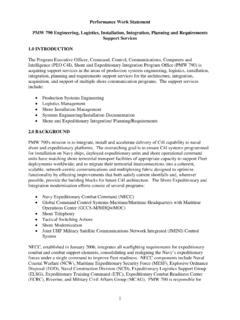Transcription of Support Services (PMW 790) and SPAWAR Shore Fleet ...
1 Support Services Systems Acquisition, Systems Engineering, Logistics, Installation Management and Shore Integration Design and Planning For Shore and Expeditionary Integration Program Office (PMW 790) and SPAWAR Shore Fleet Readiness Directorate (FRD). Performance Work Statement INTRODUCTION. The Shore and Expeditionary Integration Program Office, PMW790, and the SPAWAR FRD is acquiring Support Services in the areas of production systems engineering, logistics, installation management, and integration/planning/requirements Services for the architecture, integration, acquisition, and Support of multiple Shore and expeditionary C4I programs. The Support Services include: Production Systems Engineering Logistics Management Shore Installation Management Systems Engineering/Installation Documentation Shore and Expeditionary Integration Planning and Design BACKGROUND. The Shore and Expeditionary Integration Program Office's (PMW 790) and SPAWAR FRD.
2 Shore mission is to acquire, integrate, deliver, and Support interoperable Shore -based C4I. FORCEnet capabilities for the warfighter. PMW 790's vision is to be the preeminent provider of integrated Shore -based transformational Network Centric Warfare capabilities to the warfighter. The overarching goal is to ensure C4I systems programmed for installation on Navy ships have matching Shore facilities of appropriate capacity to Support Fleet deployments worldwide. Our goal is to migrate the Shore sites and their terrestrial interconnections into a coherent, scalable, network-centric communications and multiplexing fabric designed to optimize functionality by effecting improvements that both satisfy current shortfalls and, wherever possible, provide the building blocks for future C4I architecture. The Shore and expeditionary integration modernization efforts consist of several programs and projects: A.
3 Deployable Joint Command and Control (DJC2) is a Secretary of Defense (SECDEF) and Chairman, Joint Chiefs of Staff (CJCS) priority Department of Defense transformation initiative that is providing a standardized, integrated, rapidly deployable, modular, scalable, and reconfigurable joint command and control (C2) capability to designated Geographic Combatant Commands (GCCs). DJC2 is the material solution to Defense Planning Guidance that called for the development of Standing Joint Task Forces (JTFs) and a deployable C2. capability. DJC2 ensures Joint Force Commanders (JFCs) are equipped to carry out their C2. responsibilities. DJC2 provides GCCs and JFCs a mission critical, integrated family of C2. software applications and systems with which to plan, control, coordinate, execute, and assess military operations. It is designed to deploy rapidly, set up within hours, and quickly provide necessary C2 mission and collaboration functionality across the full spectrum of JTF.
4 Operations. GCC and JTF commanders use DJC2 for day-to-day operations, as well as when deployed for training or contingency operations. The capability is intended for all levels of conflict and is reconfigurable to meet specific GCC and JTF mission requirements. This capability is interoperable with joint, higher and adjacent echelons of command, to include coalition, allies and non-governmental organizations. This investment delivers a significant 1. increase in C2 mission efficiency and effectiveness through delivery of a standing, readily deployable C2 capability along with process and applications standardization obtained at the lowest calculated total ownership cost. DJC2 will utilize Global Command and Control System in its core suite of applications, ensuring interoperability with the worldwide- installed base of Global Command and Control System -Joint. B.
5 The Tactical Switching (TSw) program (ACAT IV-M) supports the migration of the Shore sites and their terrestrial interconnections into a coherent, scalable, network-centric capability. The TSw program rebuilds the 1970's serial based non-IP transport communications infrastructure to Net-Centric infrastructure. The primary objective is to provide the afloat customers as well as the joint users a commercially standardized technically compliant and robust network. Implementation of the TSw program objectives will increase efficiencies, reduce manpower and the overall footprint of the Navy's Shore sites. C. The Joint UHF Military Satellite Communications Network Integrated Control System (JMINI) (ACAT IV-T) is a joint interest program, directed by the Military Communications Electronics Board (MCEB) with the Navy designated as the lead service. The JMINI Control System will provide dynamic centralized control of joint 5-kHz and 25-kHz UHF.
6 MILSATCOM voice and data resources (channels and Time Division Multiple Access (TDMA) time slots). This will be accomplished via a globally integrated system of four control stations, located at the three NCTAMS sites plus Naval Computer and Telecommunications Station (NCTS) Guam. The globally integrated system consists of two major subsystems. The first subsystem, Network Management System (NMS), provides communications resource planning and management via secure Wide Area Network (WAN). connections between the control stations and remote users. The second subsystem, Channel Controller, provides the RF connectivity (modems, radios, antennas) between the NMS and the UHF MILSATCOM user terminals worldwide. The JMINI program also maintains fielded legacy channel control systems to include DAMA SAC. D. Shore Naval Messaging program (ACAT IV-M) includes the Defense Messaging System (DMS), Legacy Messaging systems, Naval Regional Enterprise Messaging System (NREMS), Tactical Messaging Gateway (TMG), Nuclear Command, Control &.
7 Communications (NC3), and DMS Information Assurance (IA) products. DMS is an OSD- mandated replacement for the legacy Automated Digital Network (AUTODIN) message delivery architecture; it implements a single organizational messaging system throughout DoD, with seamless strategic (ashore) and tactical (afloat) Joint interoperability. DMS also includes the IA product; Certification Authority Workstation (CAW). Legacy messaging systems which encompass NOVA, CUDIXS, DMDS, FSM, FMX/DUSC, PCMT, GateGuard, and MMS require life cycle Support management during the extended transition of tactical users from legacy messaging to DMS. NREMS is replacement to DMS. classic client-server architecture with DMS-compliant, net-centric enterprise messaging, in order to simplify software upgrades and hardware end-of-life replacements, facilitate consolidation of DMS Service Provider sites, and provide a clear migration path to Official Information Exchange (OIE) transition.
8 TMG is the messaging gateway between Shore - based organizations and the Fleet . TMG incorporates DMS core and COTS products to 2. deliver DMS messages and attachments to the Fleet . The TMG acts as a proxy for the afloat units and submits messages into the DMS backbone. E. Tactical Messaging (ACAT IV-T), formerly known as Naval Modular Automated Communication System II (NAVMACS II)/Single Message Solution (SMS), automates and increases the speed and efficiency of handling organizational message traffic aboard ships. Official Information Exchange (OIE) material solutions are being procured to replace the older NAVMACS systems, which lack the speed and capacity to handle current message traffic loads during periods of accelerated combat operations. Tactical DMS satisfies Multi- command Requirements of Operational Capability (MROC) requirements to transition to IP. based organizational messaging.
9 Tactical Messaging uses Commercial Off-the-Shelf (COTS). hardware and software, Government Off-the-Shelf (GOTS) furnished software, developmental software, and DMS software to provide a technologically improved shipboard message processing system capable of exchanging messages electronically between afloat units and organizations, and individuals in DoD and other federal agencies. The system features public key infrastructure (PKI) signed and encrypted email transfers to/from an afloat unit with the Tactical Messaging Gateway (TMG) enclaves located at the two Naval Computer and Telecommunications Area Master Stations (NCTAMS). The TMG acts as a proxy for the afloat units. Tactical Messaging continues to provide Navy requirements management and product certification. Tactical Messaging retains the Submarine Messaging implementation requirement. The Tactical Messaging Systems will be modified under the Command and Control Official Information Exchange (C2 OIX) project to address obsolescence issues.
10 F. The Shore Telephony project provides command and control voice capability to Naval installations worldwide. This effort has three primary areas of focus: modernizing and replacing telephone switches and cable plants worldwide in accordance with the Defense Information Systems Agency Universal Communications Requirements (DISA UCR) 2008;. participating in the Department of Navy Chief Information Officer Telecommunications Working Group (DTWG) development of a corporate strategy for enterprise approach to Navy voice; and development and implementation of the Shore Telephony Regionalization Plan. The first area of focus is Naval Networks Warfare Command (NNWC) telephone switch replacement/modernization, which replaces obsolete telephone switches and upgrades firmware, hardware, and software on a progressive schedule at the NNWC telephone switch locations and modernizes telephone switch cable plant.





